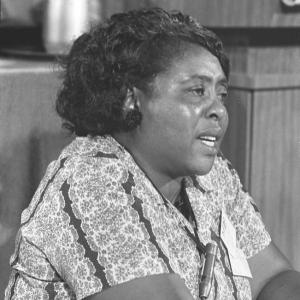During the mid-20th century, the Civil Rights Movement in America was at its height; many iconic black activists pushed the movement forward with the utmost dedication and perseverance. However, despite having the same general goals, most of said activists had their own reasons, arguments, and solutions. Two such people are Fannie Lou Hamer, a co-founder of the Freedom Democratic Party, and Martin Luther King Jr., a Christian minister and spokesperson for the movement. Although both Hamer and King fought for desegregation and black rights in America, they didn’t necessarily make the same arguments or approach the same audience.
One of Hamer’s most well-known speeches is “I’m Sick and Tired of Being Sick and Tired,” in which she attempts to convince her audience to vote in support of black rights. In her speech, she demonstrates the problem with segregation in the form of personal experiences; Hamer describes her attempts to register for voting, which were made virtually impossible by racist white people. She mentions the unfair literacy test, unreasonable fines, and police brutality she dealt with, including disturbing descriptions like, “her clothes had been ripped off from the shoulder down to the waist. Her hair was standing up on her head. Her mouth was swollen and bleeding. And one of her eyes looked like blood” (Hamer). She brings up the mistreatment of black people to show her audience that this violent behavior cannot be tolerated any longer. To further support her claims, Hamer utilizes the fact that she has been to many places, such as Chicago and Harlem, and has consistently witnessed issues with segregation across the map.

On the other hand, Martin Luther King Jr., in his “Letter from Birmingham Jail,” attempts to persuade is audience from a legal perspective; He quotes St. Augustine, who says, “An unjust law is no law at all,” then extends this statement with his own definition of an unjust law, which he describes as, “a code that a majority inflicts on a minority that is not binding on itself” (King). He applies this idea to the issue of segregation, claiming that the white majority created the separate but equal law without allowing black people a say in the matter. He also draws parallels with Hitler’s Germany, citing that, “everything Hitler did in Germany was ‘legal’ and everything the Hungarian freedom fighters did in Hungary was ‘illegal.’ It was ‘illegal’ to aid and comfort a Jew in Hitler’s Germany” (King). By comparing segregation with Hitler, King clearly demonstrates how laws are not absolutely just.

Not only are their arguments based on different aspects of segregation, Hamer and King also target different audiences. In Hamer’s case, her speech has a very broad audience; both white and black Americans have reason to listen to her, as she attempts to incite guilt in her white listeners and anger in her black listeners. Also, her authority as someone who has experienced much of the black population’s suffering can not be undermined by anyone from either side. Despite this position of authority, however, Hamer still maintains a position closer to the general American community by speaking more colloquially, such as when she says, “yes, a lot of people will roll their eyes at me today but I’m going to tell you just like it is.” King, in contrast, focuses primarily on a white audience; the letter itself was originally addressed to white clergymen and tries to convince them that they’re wrong for not supporting the Civil Rights Movement. His argument is not as relevant to a black audience as there’s no need to convince them that segregation is unjust towards them. Also, unlike Hamer, King uses more complex vocabulary to establish himself as an educated man; by doing so, it would be more difficult for his authority to be discounted. Although both activists have the same goal of furthering the Civil Rights Movement, Hamer and King have very different approaches to their argument.
Works Cited
Hamer, Fannie Lou. “I’m Sick and Tired of Being Sick and Tired.” Veterans of the Civil Rights Movement — I’m Sick and Tired of Being Sick and Tired, http://www.crmvet.org/docs/flh64.htm.
King, Martin Luther. “Letter From a Birmingham Jail.” The Martin Luther King, Jr., Research and Education Institute, 11 July 2017, kinginstitute.stanford.edu/king-papers/documents/letter-birmingham-jail.